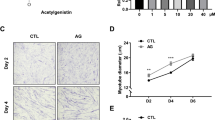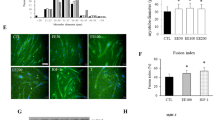Abstract
High doses or prolonged use of the exogenous synthetic glucocorticoid dexamethasone (Dex) can lead to muscle atrophy. In this study, the anti-atrophic effects of ginsenosides Rh1, Rg2, and Rg3 on Dex-induced C2C12 myotube atrophy were assessed by XTT, myotube diameter, fusion index, and western blot analysis. The XTT assay results showed that treatment with Rh1, Rg2, and Rg3 enhanced cell viability in Dex-injured C2C12 myotubes. Compared with the control group, the myotube diameter and fusion index were both reduced in Dex-treated cells, but treatment with Rh1, Rg2, and Rg3 increased these parameters. Furthermore, Rh1, Rg2, and Rg3 significantly downregulated the protein expression of FoxO3a, MuRF1, and Fbx32, while also upregulating mitochondrial biogenesis through the SIRT1/PGC-1α pathway. It also prevents myotube atrophy by regulating the IGF-1/Akt/ mTOR signaling pathway. These findings indicate that Rh1, Rg2, and Rg3 have great potential as useful agents for the prevention and treatment of muscle atrophy.






Similar content being viewed by others
References
Choi KT. Botanical characteristics, pharmacological effects and medicinal components of Korean Panax ginseng CA Meyer. Acta Pharmacologica Sinica. 29: 1109-1118 (2008)
Ghafouri-Fard S, Abak A, Khademi S, Shoorei H, Bahroudi Z, Taheri M, Dilmaghani NA. Functional roles of non-coding RNAs in atrophy. Biomedicine & Pharmacotherapy. 141: 111820 (2021)
Glass DJ. Signalling pathways that mediate skeletal muscle hypertrophy and atrophy. Nature cell biology. 5: 87-90 (2003)
Gouspillou G, Sgarioto N, Norris B, Barbat-Artigas S, Aubertin-Leheudre M, Morais JA, Burelle Y, Taivassalo T, Hepple RT. The relationship between muscle fiber type-specific PGC-1α content and mitochondrial content varies between rodent models and humans. PloS one. 9: e103044 (2014)
Jäger S, Handschin C, St.-Pierre J, Spiegelman BM (2007)AMP-activated protein kinase (AMPK) action in skeletal muscle via direct phosphorylation of PGC-1α. Proceedings of the national academy of sciences. 104: 12017-12022
Jung JS, Ahn JH, Le TK, Kim DH, Kim HS. Protopanaxatriol ginsenoside Rh1 inhibits the expression of matrix metalloproteinases and the in vitro invasion/migration of human astroglioma cells. Neurochemistry International. 63: 80-86 (2013)
Kadmiel M, Cidlowski JA. Glucocorticoid receptor signaling in health and disease. Trends in pharmacological sciences. 34: 518-530 (2013)
Kim JH, Yi YS, Kim MY, Cho JY. Role of ginsenosides, the main active components of Panax ginseng, in inflammatory responses and diseases. Journal of ginseng research. 41: 435-443 (2017)
Kim IY, Park S, Jang J, Wolfe RR. Understanding muscle protein dynamics: technical considerations for advancing sarcopenia research. Annals of geriatric medicine and research. 24: 157 (2020)
Lee SJ, Bae JH, Lee H, Lee H, Park J, Kang JS, Bae GU. Ginsenoside Rg3 upregulates myotube formation and mitochondrial function, thereby protecting myotube atrophy induced by tumor necrosis factor-alpha. Journal of ethnopharmacology. 242: 112054 (2019)
Li Q, Wu J, Huang J, Hu R, You H, Liu L, Wang D, Wei L. Paeoniflorin ameliorates skeletal muscle atrophy in chronic kidney disease via AMPK/SIRT1/PGC-1α-mediated oxidative stress and mitochondrial dysfunction. Frontiers in pharmacology. 13: 662 (2022)
Liu J, Peng Y, Wang X, Fan Y, Qin C, Shi LE, Tang Y, Li H, Long J, Liu J. Mitochondrial dysfunction launches dexamethasone-induced skeletal muscle atrophy via AMPK/FOXO3 signaling. Molecular pharmaceutics. 13: 73-84 (2016)
Mankhong S, Kim S, Moon S, Kwak HB, Park DH, Kang JH. Experimental models of sarcopenia: bridging molecular mechanism and therapeutic strategy. Cells. 9: 1385 (2020)
Oh HJ, Jin H, Kim BY, Lee OH, Lee BY. A Combined Angelica gigas and Artemisia dracunculus Extract Prevents Dexamethasone-Induced Muscle Atrophy in Mice through the Akt/mTOR/FoxO3a Signaling Pathway. Cells. 11: 3245 (2022)
Peris-Moreno D, Taillandier D, Polge C. MuRF1/TRIM63, master regulator of muscle mass. International Journal of Molecular Sciences. 21: 6663 (2020)
Ren Y, Wang JL, Zhang X, Wang H, Ye Y, Song L, Wang YJ, Tu MJ, Wang WW, Yang L, Jiang B. Antidepressant-like effects of ginsenoside Rg2 in a chronic mild stress model of depression. Brain research bulletin. 134: 211-219 (2017)
Rennie MJ, Selby A, Atherton P, Smith K, Kumar V, Glover EL, Philips SM. Facts, noise and wishful thinking: muscle protein turnover in aging and human disuse atrophy. Scandinavian journal of medicine & science in sports. 20: 5-9 (2010)
Ricketson D, Hostick U, Fang L, Yamamoto KR, Darimont BD. A conformational switch in the ligand-binding domain regulates the dependence of the glucocorticoid receptor on Hsp90. Journal of molecular biology. 368: 729-741 (2007)
Romanello V, Sandri M. The connection between the dynamic remodeling of the mitochondrial network and the regulation of muscle mass. Cellular and Molecular Life Sciences. 78: 1305-1328 (2021)
Rommel C, Bodine SC, Clarke BA, Rossman R, Nunez L, Stitt TN, Yancopoulos GD, Glass DJ (2001) Mediation of IGF-1-induced skeletal myotube hypertrophy by PI (3) K/Akt/mTOR and PI (3) K/Akt/GSK3 pathways. Nature cell biology. 3: 1009-1013
Rudrappa SS, Wilkinson DJ, Greenhaff PL, Smith K, Idris I, Atherton PJ. Human skeletal muscle disuse atrophy: effects on muscle protein synthesis, breakdown, and insulin resistance—a qualitative review. Frontiers in physiology. 7: 361 (2016)
Santo EE, Stroeken P, Sluis PV, Koster J, Versteeg R, Westerhout EM. FOXO3a Is a Major Target of Inactivation by PI3K/AKT Signaling in Aggressive NeuroblastomaTumor Suppressive Role of FOXO3a in Neuroblastoma. Cancer research. 73: 2189-2198 (2013)
Schakman O, Kalista S, Barbé C, Loumaye A, Thissen JP. Glucocorticoid-induced skeletal muscle atrophy. The international journal of biochemistry & cell biology. 45: 2163-2172 (2013)
Singh A, Phogat J, Yadav A, Dabur R. The dependency of autophagy and ubiquitin proteasome system during skeletal muscle atrophy. Biophysical Reviews. 13: 203-219 (2021)
Veliça P, Bunce CM. A quick, simple and unbiased method to quantify C2C12 myogenic differentiation. Muscle & nerve. 44: 366-370 (2011)
Wang CZ, Aung HH, Zhang B, Sun S, Li XL, He H, Xie JT, He TC, Du W, Yuan CS. Chemopreventive effects of heat-processed Panax quinquefolius root on human breast cancer cells. Anticancer research. 28: 2545-2551 (2008)
Wijaya YT, Setiawan T, Sari IN, Park K, Lee CH, Cho KW, Lee YK, Kim JY, Yoon JK, Lee SH, Kwon HY. Ginsenoside Rd ameliorates muscle wasting by suppressing the signal transducer and activator of transcription 3 pathway. Journal of Cachexia, Sarcopenia and Muscle. 13: 3149-3162 (2022)
Yang Y, Yang J, Yu Q, Gao Y, Zheng Y, Han L, Ding X. Regulation of yak longissimus lumborum energy metabolism and tenderness by the AMPK/SIRT1 signaling pathways during postmortem storage. Plos one. 17: e0277410 (2022)
Yeon M, Choi H, Chun KH, Lee JH, Jun HS. Gomisin G improves muscle strength by enhancing mitochondrial biogenesis and function in disuse muscle atrophic mice. Biomedicine & Pharmacotherapy. 153: 113406 (2022)
Yin Z, Tian Y, Cai Y, Qi L, Yuan C, Liu J, Xu T. Mitochondrial activity as an indicator of scallop (Mizuhopecten yessoensis) adductor muscle in early cold storage. Journal of Food Science. 87: 206-215 (2022)
Yoshida T, Delafontaine P. Mechanisms of IGF-1-mediated regulation of skeletal muscle hypertrophy and atrophy. Cells. 9: 1970 (2020)
Yuan Y, Cruzat VF, Newsholme P, Cheng J, Chen Y, Lu Y. Regulation of SIRT1 in aging: roles in mitochondrial function and biogenesis. Mechanisms of ageing and development. 155: 10-21 (2016)
Zhang L, Zhang L, Wang X, Si H. Anti-adipogenic effects and mechanisms of ginsenoside Rg3 in pre-adipocytes and obese mice. Frontiers in Pharmacology. 8: 113 (2017)
Acknowledgements
This research was funded by the Ministry of SMEs and Startups (Grant No. S3241314), the Basic Science Research Program (NRF-2021R1A6A1A03044242) through the National Research Foundation of Korea (NRF) funded by the Ministry of Education, the BK21 FOUR (Fostering Outstanding Universities for Research) funded by the Ministry of Education (MOE, Korea) and National Research Foundation of Korea (NRF) (Grant No. 4299990913942).
Author information
Authors and Affiliations
Corresponding authors
Ethics declarations
Conflict of interest
None of the authors of this study has any financial interest or conflict with industries or parties.
Additional information
Publisher’s Note
Springer Nature remains neutral with regard to jurisdictional claims in published maps and institutional affiliations.
Rights and permissions
Springer Nature or its licensor (e.g. a society or other partner) holds exclusive rights to this article under a publishing agreement with the author(s) or other rightsholder(s); author self-archiving of the accepted manuscript version of this article is solely governed by the terms of such publishing agreement and applicable law.
About this article
Cite this article
Men, X., Han, X., Lee, SJ. et al. Ginsenosides Rh1, Rg2, and Rg3 ameliorate dexamethasone-induced muscle atrophy in C2C12 myotubes. Food Sci Biotechnol 33, 1233–1243 (2024). https://doi.org/10.1007/s10068-023-01407-w
Received:
Revised:
Accepted:
Published:
Issue Date:
DOI: https://doi.org/10.1007/s10068-023-01407-w




